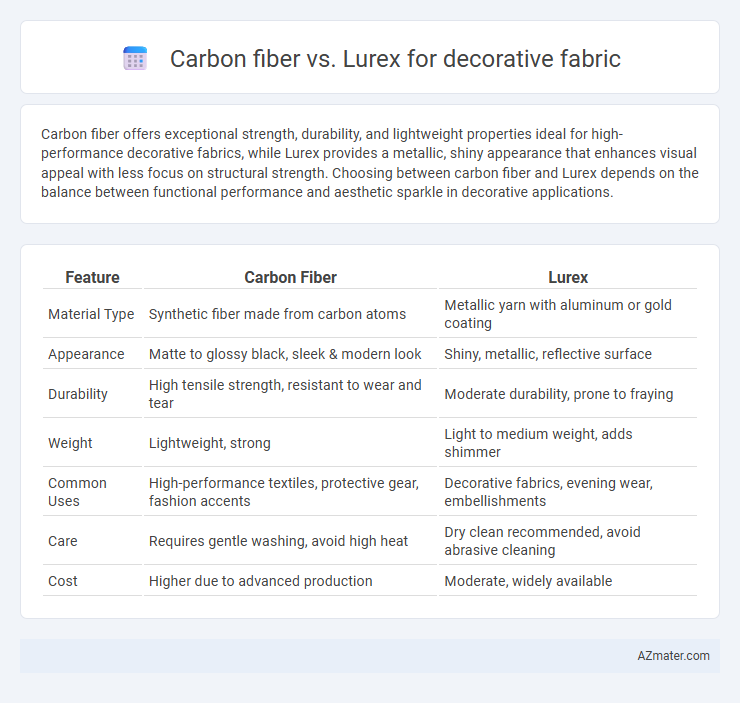Carbon fiber offers exceptional strength, durability, and lightweight properties ideal for high-performance decorative fabrics, while Lurex provides a metallic, shiny appearance that enhances visual appeal with less focus on structural strength. Choosing between carbon fiber and Lurex depends on the balance between functional performance and aesthetic sparkle in decorative applications.
Table of Comparison
| Feature | Carbon Fiber | Lurex |
|---|---|---|
| Material Type | Synthetic fiber made from carbon atoms | Metallic yarn with aluminum or gold coating |
| Appearance | Matte to glossy black, sleek & modern look | Shiny, metallic, reflective surface |
| Durability | High tensile strength, resistant to wear and tear | Moderate durability, prone to fraying |
| Weight | Lightweight, strong | Light to medium weight, adds shimmer |
| Common Uses | High-performance textiles, protective gear, fashion accents | Decorative fabrics, evening wear, embellishments |
| Care | Requires gentle washing, avoid high heat | Dry clean recommended, avoid abrasive cleaning |
| Cost | Higher due to advanced production | Moderate, widely available |
Introduction: Comparing Carbon Fiber and Lurex in Decorative Fabrics
Carbon fiber offers exceptional strength, durability, and a sleek, modern aesthetic that enhances decorative fabrics with high performance and lightweight qualities. Lurex provides a shimmering metallic finish created from aluminum-coated synthetic fibers, ideal for adding sparkle and glamour to textiles. Comparing these materials highlights carbon fiber's industrial, high-tech appeal versus Lurex's decorative, eye-catching brilliance in fabric applications.
Material Composition: Carbon Fiber vs Lurex
Carbon fiber fabric consists of tightly woven carbon filaments known for exceptional strength, durability, and lightweight properties, making it ideal for high-performance applications. Lurex fabric incorporates metallic fibers blended with synthetic yarns to create a shimmering, decorative effect, prioritizing aesthetic appeal over structural strength. The material composition of carbon fiber emphasizes performance and resilience, while Lurex focuses on visual impact and ornamental use in decorative textiles.
Aesthetic Appeal and Visual Effects
Carbon fiber offers a sleek, modern aesthetic with a subtle metallic sheen that enhances contemporary decorative fabric designs through its woven texture and light-reflective properties. Lurex fabric captivates with its vibrant, shimmering threads that create dynamic visual effects, making it ideal for eye-catching, glamorous decor. The choice between carbon fiber and Lurex hinges on the desired ambiance--carbon fiber for minimalist sophistication and Lurex for bold, sparkling elegance.
Texture and Feel: Tactile Differences
Carbon fiber fabric offers a smooth, sleek texture with a slightly rigid feel due to its tightly woven synthetic fibers, making it ideal for modern, high-tech decorative applications. Lurex fabric features a metallic sheen and a softer, more flexible texture with a slightly rougher surface due to its metallic threads, adding shimmer and tactile interest to decorative pieces. The tactile differences between carbon fiber and Lurex fabrics influence their suitability for various decorative styles, with carbon fiber providing a futuristic, structured feel and Lurex imparting a glamorous, textured finish.
Strength and Durability Considerations
Carbon fiber offers exceptional strength-to-weight ratio and superior durability, making it ideal for decorative fabrics requiring long-lasting structural integrity and resistance to wear. Lurex, while visually appealing due to its metallic sheen, is less robust and tends to degrade with frequent use or exposure to friction, limiting its longevity in high-stress decorative applications. Selecting carbon fiber-infused fabrics ensures enhanced tensile strength and minimal degradation, optimizing both aesthetic and functional performance.
Flexibility and Weaving Techniques
Carbon fiber offers exceptional flexibility and strength, making it suitable for intricate weaving techniques like twill and plain weave that enhance both durability and aesthetic appeal in decorative fabrics. Lurex incorporates metallic threads that provide a shimmering effect but typically exhibits less flexibility and requires specialized weaving methods such as jacquard or dobby to maintain fabric integrity. The contrasting properties of carbon fiber and Lurex influence their application in decorative textiles, balancing flexibility with visual impact through advanced weaving technologies.
Weight and Fabric Structure
Carbon fiber fabric is significantly lighter than Lurex, enhancing its suitability for applications requiring minimal weight without compromising strength. The fabric structure of carbon fiber features tightly woven graphite filaments, providing superior durability and rigidity compared to Lurex's metallic threads embedded in softer base textiles. While Lurex offers visual appeal with its shiny, decorative effect, its heavier and less dense fabric structure makes it less optimal for lightweight functional uses.
Color Options and Reflective Qualities
Carbon fiber decorative fabrics are typically available in limited color options, mostly black or dark gray, but they excel in durability and lightweight strength with subtle reflective qualities due to their inherent sheen. Lurex fabrics offer a wide range of vibrant color options and superior reflective qualities, as they incorporate metallic threads that catch and reflect light, making them highly eye-catching for decorative use. While carbon fiber emphasizes performance and a sleek, modern aesthetic, Lurex prioritizes visual impact and versatility in color and sparkle.
Cost and Accessibility of Materials
Carbon fiber decorative fabric commands a higher price due to its advanced manufacturing process and superior strength-to-weight ratio, making it less accessible for widespread decorative use. Lurex fabric is substantially more affordable and widely available, derived from metallic yarns that are easier to produce and source, thus ideal for budget-conscious decorative applications. The cost difference directly impacts material accessibility, with Lurex dominating in market presence for decorative fabrics.
Ideal Applications in Interior and Fashion Design
Carbon fiber fabric excels in interior design applications that demand durability, lightweight strength, and a sleek, modern aesthetic, making it ideal for high-end furniture accents and structural decorative elements. Lurex fabric, characterized by its shimmering metallic threads, brings a vibrant, glamorous appeal perfect for fashion design, especially in evening wear, accessories, and statement pieces. Interior designers leverage Lurex's reflective qualities for accent pillows and drapery, while fashion designers prefer carbon fiber blends for innovative, futuristic garments combining style with performance.

Infographic: Carbon fiber vs Lurex for Decorative fabric
 azmater.com
azmater.com